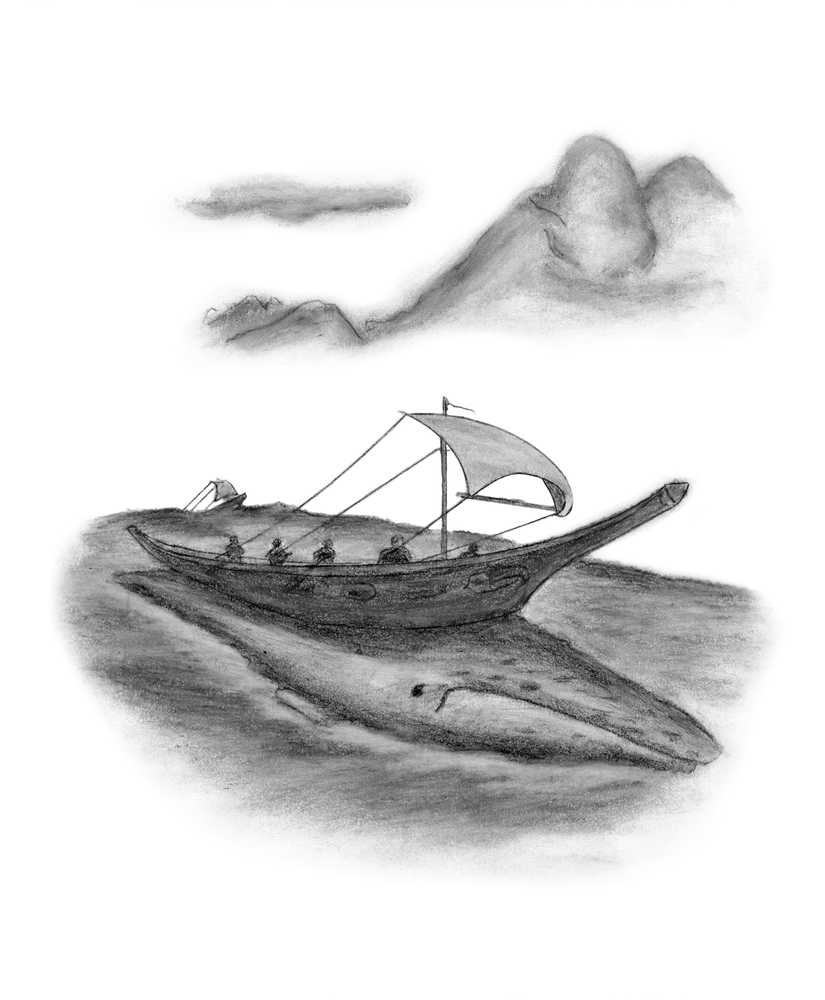More than 100 years ago, when he was just 10 years old, Roy A. Peratrovich Jr.’s grandfather, Andrew Wanamaker, traveled the 200 miles from Sitka to Ketchikan in a war canoe. He, his father, and others made the voyage to right a wrong done to one of their clan members.
Now, that journey — fictionalized — is the subject of a chapter book Peratrovich wrote and illustrated for young readers, “Little Whale.” Peratrovich is the eldest son of renowned Alaska Native civil rights leaders Elizabeth and Roy Peratrovich; Andrew Wanamaker was Elizabeth Peratrovich’s adoptive father.
Wanamaker was born in the late 1800s and died in 1969. He voyaged in one of the last Tlingit war canoes, “but he also lived to see the landing on the moon,” Peratrovich said. “It was quite a change in our culture, and along the way we kept losing our history, which is an oral history, because all of the old people were dying off and the children were trying to adjust to Western culture as best they could, and as fast as they could… In a way, my story was trying to bring a little bit back to the history of our past that made our people what we are.”
“Little Whale” focuses on the journey of a boy named Kéet (kéet means “killer whale” in Lingít, the Tlingit language) at a time Westerners and Alaska Natives were just beginning to make contact. (Kéet hasn’t yet met any Westerners, though he sees signs of their presence.) On their way to Ketchikan, Kéet, his father and the other men face a storm and make friends they never expected.
Peratrovich has been working with Annie Boochever, author of the middle-grade book “Bristol Bay Summer,” on a children’s book about his mother’s life. Boochever encouraged him to turn the story of his grandfather’s journey into a book.
“She thought it was a wonderful story, and she said ‘You ought to write that down, if nothing else, for your children,” Peratrovich said.
He did — and one thing led to another. The story grew. It developed chapters. He began making illustrations. He faced disheartening edits. But his wife Toby Peratrovich, daughter betsy Peratrovich (she does not capitalize her first name), and Boochever, as well as other people, helped him.
“Somewhere along the way, I got hooked, and I was writing a book,” he said.
Somewhere else along the way, a young whale and its pod entered the story, as well. Peratrovich thinks that element of the story may have been inspired by a bronze sculpture he made of a canoe riding atop a diving whale.
Other family members also made it into the book — a childhood picture of grandson Christopher Roy Peratrovich (who is now grown, and a propulsion engineer) served as the basis for an illustration of Kéet; and the book is dedicated to his sons Mike and Doug (Andrew Wanamaker gave Doug the Tlingit name Kéet) and daughter betsy.
Peratrovich was born in Klawock. He moved to Juneau in 1941 and became one of the first Alaska Natives to attend public school with non-Native children; he graduated high school in Colorado in 1953, graduated from the University of Washington with a civil engineering degree in 1957, and returned to Juneau with his family from 1961 to 1972, when they moved to Anchorage. His career in engineering spanned 43 years, and he was the first Alaska Native civil engineer registered in Alaska.
In 1979, he and Dennis Nottingham started PND Engineers, which has offices in Juneau, Anchorage and Seattle. When he got close to retiring, he returned to art, which he hadn’t done much of since high school, he said. Then he started Ravenworks Art Studio, where he focuses on bronze sculptures.
Alaskans may also be familiar with Peratrovich’s work from other venues. He created the bust of his mother on display in the Capitol building; he designed the original Brotherhood Bridge (the medallions he designed are on display on the new one) and his work is on display at Roy and Elizabeth Peratrovich Park in Anchorage.
“Little Whale” also features “Words to Know” in Lingít, an introduction that explains cultural context for those who that may not be familiar with it, a map of the journey, and praise from readers, leaders and fellow authors. Sealaska Heritage Institute president Rosita Worl, who helped Peratrovich authenticate Tlingit customs for the time period in which the book is placed, wrote that “Little Whale” “provides a rare glimpse into the daily lives of the Tlingit prior to the changes that occurred with the arrival of Westerners… Mr. Peratrovich’s story reveals the warmth and humanity of the Tlingit who are more often portrayed as warriors.”
Asked if there will be any more books, Peratrovich said “When I finished that book, I figured this is my first and last one, but my daughter and my wife keep saying ‘Do more.’” (“Do more!” his wife called out in the background.) “My wife keeps reminding me that the Tlingits are natural storytellers,” he added.
The book will soon be available at local bookstores and can be purchased on Amazon and from the University of Alaska Press.
• Contact Capital City Weekly managing editor Mary Catharine Martin at maryc.martin@capweek.com.

